
Originally published in The Clarinet 52/3 (June 2025).
Copies of The Clarinet are available for ICA members.
Exploring Synthetic Reeds
In this guide to synthetic reeds, Bret Pimentel examines many of the current offerings from manufacturers and addresses common questions about these alternatives to cane reeds.
by Bret Pimentel
For hundreds of years clarinetists have dealt with the frustrations of reeds made from natural cane: inconsistency, unpredictability, and a too-short lifespan. In recent years, more and more enterprising reedmakers have turned to synthetic materials as a possible replacement, with promises of stable, reliable, long-lasting reeds. Notably, even some of the best-known makers of cane reeds have announced their own synthetic reeds in recent years.
WHAT’S AVAILABLE?
I recently reached out to companies producing synthetic reeds (primarily for B-flat soprano Boehm clarinets) for some samples. Here’s what I learned about the products currently on the market. (These are listed in alphabetical order.) [This article is for informational purposes only, as The Clarinet does not publish product reviews. Ed.]
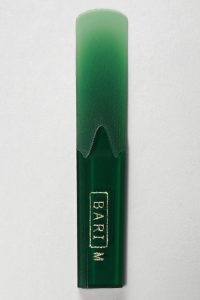
Eco

Elite
BARI WOODWINDS, INC.
Samples tested: “Eco” and “Elite” models, both in strengths from medium soft to medium hard.
Other products available: Some additional models, and strengths from soft to hard. Bari also offers reeds for bass clarinet and for SATB (soprano, alto, tenor, and baritone) saxophones.
Description: Smooth, transparent synthetic material with a matte texture on the vamp. The colors are vibrant green (“Eco”) and red (“Elite”), and the Elite model also features an embedded rhinestone in the reed’s heart area. If you want your reed to make a statement, the Elite is for you!
Notable claims from the company (from marketing materials, product packaging, etc.): “Bari Eco reed is made from recycled material.” “Bari reeds can be clipped and shaved.”
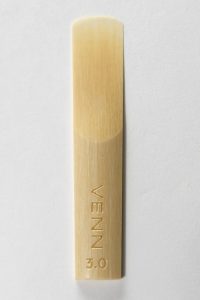
VENN

Plasticover (front and back views)
D’ADDARIO & CO.
Samples tested: “VENN” model in strengths 2.5 to 3.5+ and “Plasticover by D’Addario” in 3.5 and 4.0.
Other products available: VENN reeds in half strengths from 2.0 to 4.0, and in 3.5+, also available for alto and tenor saxophone. Plasticover reeds are available in half strengths from 1.5 to 4.0 and for SATB saxophones.
Description: VENN reeds are made from a smooth, slightly slippery synthetic material with apparent fibrous structure and natural cane color, hard to distinguish visually from cane at a glance. The Plasticovers are natural cane reeds with a thin black synthetic coating on the vamp, sides, and table.
Notable claims from the company: “With proper care for the tip of the reed, VENN is designed to provide roughly 3-6 months of playing.” “[Plasticover] features a unique coated formula for increased durability and weather resistance.”
Exchange/guarantee: “VENN Alternate Strength Program” offers some flexibility if you pick the wrong strength.
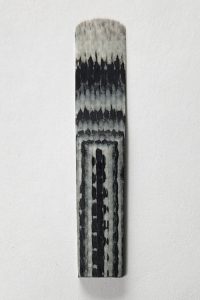
Carbon
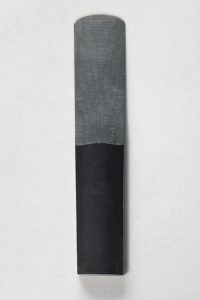
Carbon Onyx
HARRY HARTMANN’S FIBERREED
Samples tested: “Carbon,” “Carbon Onyx,” “Carbon Classic,” “Copper Carbon Classic,” “Natural Classic,” and “Hemp,” mostly in medium hard and hard strengths.
Other products available: Strengths from soft to hard or extra hard, depending on model. Fiberreeds are also available in some models for German clarinet and contrabass clarinets, and for SATB and bass saxophones. The company does not appear to offer bass clarinet models, though the tenor saxophone reeds could perhaps be a substitute.
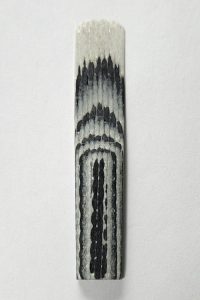
Carbon Classic
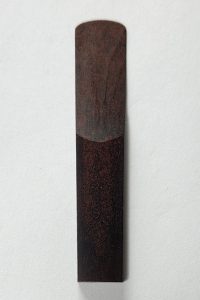
Copper Carbon Classic
Description: Smooth, slightly slippery synthetic material with apparent fibrous structure. A variety of colors, some patterned.
Notable claims from the company: “Last 20-30X longer than cane.”
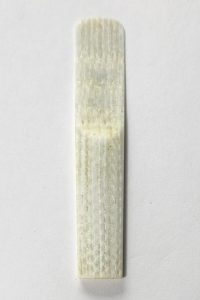
Natural
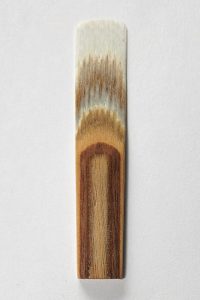
Hemp
FORESTONE JAPAN

Traditional
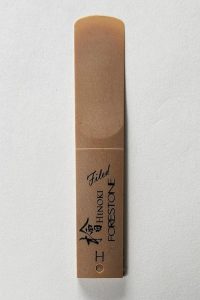
Hinoki Filed
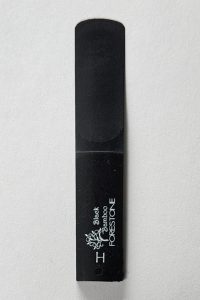
Black Bamboo
Samples tested: “Traditional,” “Hinoki Filed,” and “Black Bamboo” models, in medium hard to extra hard strengths.
Other products available: Additional models, and strengths from extra soft to extra hard. There are also models for SATB saxophones and German clarinet.
Description: Matte synthetic material. The Hinoki Filed are similar in color to natural cane, the Traditional somewhat darker brown, and the Black Bamboo are, well, black.
Notable claims from the company: “Although [adjusting is] usually not necessary … one can still do so using blades, files, sandpaper, reed rush or whatever other tool or implement is desired. One can also clip Forestone reeds successfully.”
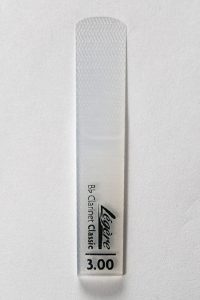
Classic
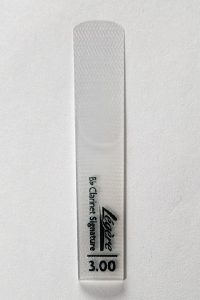
Signature
LÉGÈRE REEDS LTD.
Samples tested: “Classic,” “Signature,” “French Cut,” and “European Cut” models in strengths from 3.0 to 3.75.
Other products available: Quarter strengths from 2.5 to 4.5 depending on model. There are some models available for E-flat clarinet, bass clarinet, contrabass clarinet, German clarinet, SATB and bass saxophones, oboe, and bassoon.
Description: Matte translucent synthetic material.
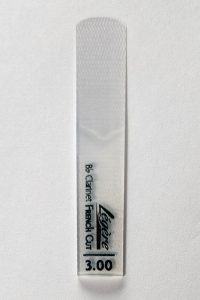
French Cut
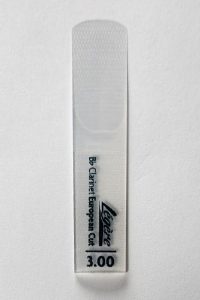
European Cut
Exchange/guarantee: “Exchange of Strength” program noted on company website provides some assistance in finding your best match.
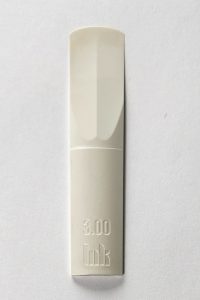
Leitner & Kraus
LEITNER & KRAUS
Samples tested: quarter strengths from 2.25 to 4.25.
Description: Smooth, white, slightly slippery synthetic material with a pronounced spine. Since they are intended for German or Reform-Boehm clarinets, these reeds are slightly wider than the other reeds tested.
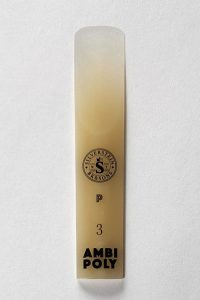
Primo
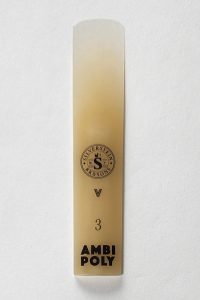
Vivace
SILVERSTEIN WORKS
Samples tested: “Ambipoly Primo” and “Ambipoly Vivace” models in strengths 3.0 to 3.5.
Other products available: Ambipoly “Maesta,” “Student,” “Marching • Band,” and “Blue” models in quarter or half sizes from 2.0 to 4.0 depending on model. Additional models available for E-flat, bass, and German clarinet, SATB saxophones, oboe, and bassoon.
Description: Matte translucent synthetic material, cane-like in color.
Notable claims from the company: “In most circumstances, an Ambipoly reed plays for 12 months+.” Marketing materials indicate that these reeds, unlike most synthetic reeds, should be soaked before use (“30 seconds wet, last for 5+ hours without drying”).
Exchange/guarantee: Some models are covered by a 6-month “reed life” guarantee, and a “3-piece reed trial” can help players find the correct strength.
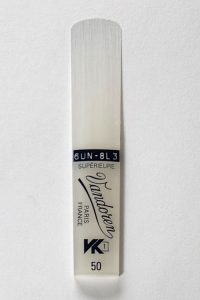
VK1
VANDOREN PARIS
Samples tested: “VK1” model in strengths 45, 50, and 55. Other products available: strengths from 35 to 60 in increments of 5. Currently only available for B-flat clarinet.
Description: Smooth, translucent synthetic material with apparent fibrous structure.
Notable claims from the company: “The VK reed strengths correspond to a 1/6 of a cane reed strength.”
OTHER
I am aware of three other companies making synthetic reeds, which I wasn’t able to contact successfully and haven’t tested: Bravo Reeds, Faxx, and Fibracell. Their products appear to be available through retailers.
TESTING RESULTS
I invited clarinet students from Mississippi State University and the University of Mississippi (thanks, Professor Michael Rowlett!) to test the reeds and share their thoughts. Here are some takeaways:
- Appearance: Brightly-colored reeds drew mixed reactions. Some testers liked the flair, but others worried about judgment from stuffier colleagues and conductors.
- Surface: Most of the reeds felt a little “grippy” like cane, but a few were noticeably slippery. Some testers found this frustrating when aligning reeds on mouthpieces, but some also liked the smooth feel against their lip.
- Strength: Reed “strength” was a significant factor for most testers. Strength mismatches seemed even more pronounced than with cane. Many testers needed a slightly softer strength than expected.
- Function: Most reeds proved functional across the clarinet’s range, with good response and stability when properly matched strength-wise.
- Familiarity: Many testers expected to like the synthetic offerings by their favorite cane reedmakers. This turned out to be somewhat hit-or-miss.
- Sound and feel: Preferences varied widely, as expected. Most testers identified at least one synthetic reed that they liked well enough to consider purchasing.
- Cost: The testers, mostly university students, had concerns about costs. Most synthetic reeds cost about the same as a box of cane reeds; they didn’t like the idea of spending that much for a reed that might not be a match.
ARE SYNTHETIC REEDS A VIABLE OPTION?
Yes. Synthetics may or may not suit you as an everyday choice. But they can be a valuable tool for special circumstances: doubling, outdoor gigs, or as reliable backups. And an increasing number of professional clarinetists use them in high-profile performances.
CAN YOU TELL THE DIFFERENCE BETWEEN CANE AND SYNTHETIC?
Just like different cane reeds respond differently, you can expect to adapt a little to a new synthetic reed. In my observations, the differences between a good cane reed and the right synthetic one are minimal (for players and for listeners), and often outweighed by synthetics’ consistency and durability.
WHAT STRENGTH OR MODEL SHOULD I GET?
Many synthetic reed manufacturers have strength comparison charts on their websites. These may be helpful as a rough starting point, but proceed with caution. Many of the charts use cane reeds by major manufacturers (usually models by Vandoren and/or D’Addario) as points of comparison, but the charts do not always agree even on how two cane reeds from the same manufacturer compare to each other. This may be a result of differing ideas about what reed strength is and how to measure it. Additionally, my testers often disagreed among themselves about how synthetic reeds compared to each other in strength.
Some manufacturers specify performance characteristics for each model, such as brightness/darkness, resonance, or projection. In some cases these may be useful for comparing multiple products from the same manufacturer. However, wise clarinetists will probably take them with a grain of salt, as this kind of terminology can be imprecise, subjective, or hyperbolic.
The unfortunate truth is familiar to clarinetists: as with any part of your equipment, the only sure way to know what you like is to try it.
HOW DO YOU CHOOSE A SYNTHETIC REED?
Try as many as you can. Some manufacturers offer trials, exchanges, or sample packs.
- Tap into your network. Do you know someone who uses the same mouthpiece as you, who has found a synthetic reed that’s a good match? That could be a starting point.
- Home in gradually. If you bought a synthetic reed and it’s not quite what you hoped, the manufacturer’s website or a knowledgeable salesperson might be able to recommend a different model or strength.
- Adjust, if you dare. Some synthetic reeds can be sanded or shaved, at peril of your warranty and your fingers.
- Test different setups. Try pairing synthetic reeds with a variety of mouthpieces to find a great combination.
WHAT IS THE FUTURE OF SYNTHETIC REEDS?
With advances in manufacturing, we might someday see finer gradations of strength and even custom-tailored reeds. Before long, it may be possible to leave cane behind entirely. But even now, synthetic reeds are a compelling alternative, whether as a backup or as your new go-to.
 Bret Pimentel, DMA, has taught woodwind instruments at Delta State University and Mississippi State University. He is the author of Woodwind Basics: Core concepts for playing and teaching flute, oboe, clarinet, bassoon, and saxophone, and a popular blog for woodwind players and educators at bretpimentel.com.
Bret Pimentel, DMA, has taught woodwind instruments at Delta State University and Mississippi State University. He is the author of Woodwind Basics: Core concepts for playing and teaching flute, oboe, clarinet, bassoon, and saxophone, and a popular blog for woodwind players and educators at bretpimentel.com.
Comments are closed.